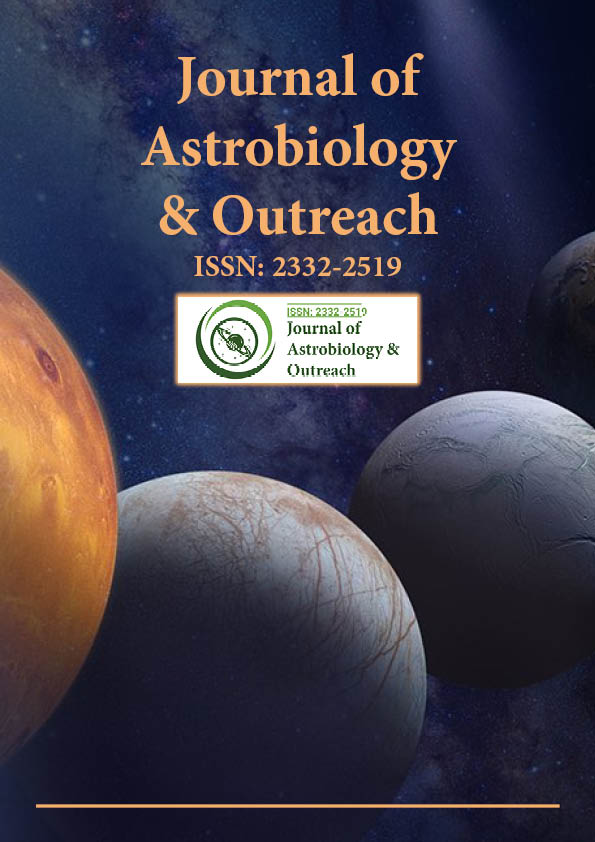Indexed In
- Open J Gate
- Academic Keys
- JournalTOCs
- RefSeek
- Hamdard University
- EBSCO A-Z
- OCLC- WorldCat
- Google Scholar
Useful Links
Share This Page
Journal Flyer

Open Access Journals
- Agri and Aquaculture
- Biochemistry
- Bioinformatics & Systems Biology
- Business & Management
- Chemistry
- Clinical Sciences
- Engineering
- Food & Nutrition
- General Science
- Genetics & Molecular Biology
- Immunology & Microbiology
- Medical Sciences
- Neuroscience & Psychology
- Nursing & Health Care
- Pharmaceutical Sciences
Commentary - (2024) Volume 12, Issue 3
Potassium Isotopes: Tracing Planetary Formation and Evolution
Carlos Fernandez*Received: 30-Aug-2024, Manuscript No. JAO-24-27912; Editor assigned: 02-Sep-2024, Pre QC No. JAO-24-27912 (PQ); Reviewed: 16-Sep-2024, QC No. JAO-24-27912; Revised: 23-Sep-2024, Manuscript No. JAO-24-27912 (R); Published: 30-Sep-2024, DOI: 10.35248/2332-2519.24.12.353
Description
Potassium (K) is an essential element with significant roles in geochemistry and cosmochemistry. The study of potassium stable isotopes provides valuable insights into planetary formation, differentiation and evolution processes, as well as the interactions between various reservoirs on Earth and other celestial bodies. Potassium, a moderately volatile element, has unique isotopic characteristics that can reveal important information about volatile behavior, planetary accretion and core-mantle-crust interactions. Recent advancements in analytical techniques have enabled precise measurements of potassium stable isotopes, moving forward our understanding of this element's geochemical and cosmochemical significance.
The isotopes of potassium, particularly 39K, 40K and 41K, exhibit mass-dependent fractionation during various geological and cosmochemical processes. These isotopic variations are influenced by processes such as evaporation, condensation, fluid-rock interactions and melting. For example, the enrichment or depletion of heavier isotopes like 41K relative to 39K can provide clues about the thermal history of planetary materials or the conditions under which they formed.
In geochemistry, potassium isotopes serve as tracers for understanding crustal and mantle processes. Potassium is a major element in silicate minerals and plays an essential role in Earth's geochemical cycles. Stable isotope studies of potassium in igneous and metamorphic rocks can help delineate the processes of partial melting, fractional crystallization and metasomatism. For example, variations in potassium isotopic compositions in mantle-derived rocks may reflect mantle heterogeneity or the influence of recycled crustal materials. Similarly, potassium isotopes in sedimentary rocks and fluids can provide insights into weathering, erosion and diagenetic processes.
Cosmochemistry, explores potassium isotopes to understand the formation and evolution of the solar system. As a moderately volatile element, potassium's behavior during planetary accretion and differentiation offers insights into volatile depletion and retention. Isotopic studies of potassium in meteorites, lunar samples and planetary crusts provide constraints on the conditions of early solar system formation. For example, isotopic compositions in chondrites the building blocks of planets—can reveal information about the distribution of volatiles during the early stages of planetesimal accretion.
The study of potassium isotopes also contributes to our understanding of planetary differentiation. During the formation of planetary cores and mantles, isotopic fractionation of potassium may occur due to its partitioning between metal and silicate phases. These fractionation patterns can help decipher the thermal and compositional evolution of planetary interiors. Additionally, potassium isotopes play a role in assessing volatile loss from planetary bodies, particularly during high-energy impacts or prolonged magmatic activity.
A significant area of interest is the application of potassium isotopes to the Moon and other planetary bodies. Lunar samples, brought back by Apollo missions, exhibit distinct potassium isotopic signatures compared to terrestrial rocks. These variations suggest that the moon experienced extensive volatile depletion, potentially during its formation via a giant impact. Similarly, isotopic studies of Martian meteorites provide insights into the red planet's volatile history, surface processes and the potential presence of liquid water.
Advancements in analytical techniques have been instrumental in the progress of potassium isotope research. High-precision methods such as multi-collector inductively coupled plasma mass spectrometry have enabled the detection of subtle isotopic variations, allowing scientists to explore previously inaccessible questions. These technologies facilitate the separation of massdependent fractionation effects from radiogenic contributions, such as those from 40K decay, which is a critical step in achieving accurate and reliable measurements.
The potential applications of potassium stable isotopes extend beyond Earth and planetary sciences. In astrobiology, potassium isotopes can provide information about the distribution of essential elements for life and the conditions under which they are retained on habitable worlds. Additionally, they provide a valuable tool for tracing the movement of fluids and volatiles in extraterrestrial environments, which has implications for understanding the potential for life on other planets.
In conclusion, the geochemistry and cosmochemistry of potassium stable isotopes represent a powerful tool for investigating planetary formation, differentiation and volatile behavior. By examining isotopic variations in terrestrial and extraterrestrial materials, researchers gain valuable insights into processes that shape planets and their histories. The continued development of analytical methods promises to unlock further potential in potassium isotope research, enabling deeper exploration of both Earth and the broader solar system. These studies not only improve our understanding of planetary science but also contribute to major questions about the origins and evolution of habitable worlds in the cosmos.
Citation: Fernandez C (2024). Potassium Isotopes: Tracing Planetary Formation and Evolution. J Astrobiol Outreach. 12:353.
Copyright: © 2024 Fernandez C. This is an open-access article distributed under the terms of the Creative Commons Attribution License, which permits unrestricted use, distribution, and reproduction in any medium, provided the original author and source are credited.

